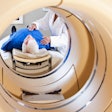Although they provide different radiation exposure levels and patient experiences, SPECT myocardial perfusion imaging (MPI) and coronary CT angiography (CCTA) produce remarkably similar outcomes in initial imaging for chest pain, according to a new study.
Over more than three years of follow-up, the two scans delivered roughly the same outcomes and resource utilization statistics among chest-pain patients who had one exam or the other, concluded lead author Dr. Jeffrey Levsky, PhD, and colleagues from Montefiore Medical Center and Albert Einstein College of Medicine.
However, patients reported a more positive experience with CCTA, and it was associated with less radiation exposure, they noted. Results of the study were published in the August 4 issue of the Annals of Internal Medicine (Vol. 163:3, pp. 174-184).
Improving outcomes
Cardiovascular disease is the leading cause of death in both men and women, and it's a key reason for patient visits to the emergency department for chest pain.
Studies have documented CCTA's diagnostic power for assessing chest pain and found it to be effective for selecting patients for coronary catheterization and revascularization. The aim is to noninvasively identify patients who need revascularization before they are sent to the cath lab, thus avoiding additional risk and costs.
"There are papers showing an alarming number of unnecessary catheterizations, and it doesn't do them any good," Levsky said in an interview with AuntMinnie.com.
Clinicians "should be doing catheterizations that lead to an intervention that helps the person -- not 'we're going to look and see if your coronaries are OK,' " he said.
Trials of low-risk patients with chest pain in the emergency department have found CT to be faster and more efficient than standard protocols. But there are concerns that CCTA may lead to more invasive management due to it finding lesions that aren't flow-obstructing.
For many doctors, choosing between CCTA and SPECT MPI for a patient with chest pain is often more about emotion and personal bias than the facts, according to Levsky.
"I think that in a lot of cases, in selecting the way we choose to image people, doctors have deep-seated and often unbalanced opinions about which of the two main ways of managing the heart -- CT and nuclear -- should be used," Levsky said.
Better patient management?
The researchers sought to compare CCTA with SPECT MPI in an inner-city, mostly poor, heavily minority population. Of this patient group, 63% were women.
"We hypothesized that, compared with MPI, CCTA would provide superior selection of patients for invasive management and decrease length of stay without compromising patient safety," the authors wrote.
Another recent study of 10,000 patients actually showed CT coming in at about 1% fewer unnecessary catheterizations versus SPECT, but CT "didn't blow the other modality out of the water," Levsky said.
In this study, 400 patients (mean age, 57 years) who presented to the emergency department with chest pain but no evidence of myocardial infarction were randomized to receive SPECT MPI or CCTA.
CT was performed on 64-detector-row scanners following beta-blocker and iodinated contrast administration. Radionuclide stress MPI was usually performed using a one-day dual-isotope technique.
The primary outcome was cardiac catheterization not leading to revascularization within a year after the exam. The researchers also looked at length of hospital stay, resource utilization, patient experience, radiation dose, and safety outcomes including death and major cardiovascular events.
Over a mean 40-month follow-up, patients were assigned to any physician from a group of about 30 imaging specialists.
Roughly equal catheterization rates
In all, 30 (15%) patients who had CCTA and 32 (16%) who underwent SPECT MPI had cardiac catheterizations within a year.
Fifteen (7.5%) of the CT patients and 20 (10%) of the MPI patients did not undergo revascularization, a trend reflected in the 2.5% difference in favor of CT, the authors wrote.
"I think that trend is true," and the larger study published this year also favored CT by 1% in terms of reducing unnecessary catheterizations, Levsky said.
"But another important trend we saw in this study is that CT seems to send more patients to [coronary artery bypass grafting (CABG)] than MPI," he said. Seven patients in the CT group and one in the MPI group were referred for CABG in the first year after imaging.
"The question is, is it going to benefit those patients," Levsky said. "If you saw them before the CT era, they just went home and didn't get a CABG. Does that patient benefit? The answer is we don't know."
The median length of hospital stay was roughly equivalent for the two exams: 28.9 hours for CCTA patients and 30.4 hours for the MPI group (p = 0.057), again with a slight trend indicating shorter stays with CT.
Other measures were also similar between the modalities, such as risk of death, nonfatal cardiovascular events, rehospitalizations, and outpatient cardiology visits. Most trended in favor of CT, but not significantly.
One significant difference between the modalities was radiation: The median effective dose was more than three times higher for MPI (27 mSv) than CCTA (9.6 mSv). The difference diminished, however, with all-cause long-term radiation exposure, which was 24 mSv for CT and 29 mSv for MPI. But both CT and MPI radiation levels have continued dropping since the study.
"If you do a head-to-head [comparison], CT still wins in most radiation, but it's a moving target," Levsky said. "In my opinion, even comparing the radiation dose between CT and a radioisotope is very shaky."
A better patient experience
Finally, in terms of patient experience, both exams received a median rating score of 2 (on a scale of 1 to 10, with 1 being best).
Meanwhile, 14% of CCTA patients (n = 28) and 23% of MPI patients (n = 45) rated their tests less positively, with scores of 5 or worse. In general, more patients graded their CT experience favorably, and more CT patients were willing to undergo the exam again, the authors wrote.
"To our knowledge, this single-center, randomized, controlled comparative effectiveness trial is the first to directly compare CCTA and MPI in acutely symptomatic, intermediate-risk patients with chest pain with intermediate-term follow-up (median, 40 months)," Levsky and colleagues wrote.
The study also differed from the norm in its inclusion of a majority female, minority, overweight population.
What's next? "We're working on a trial of coronary CTA versus stress echo, because stress echo has the obvious benefit of no radiation," Levsky said.




















